Zhiqiang Pu
CoMoE: Contrastive Representation for Mixture-of-Experts in Parameter-Efficient Fine-tuning
May 23, 2025Abstract:In parameter-efficient fine-tuning, mixture-of-experts (MoE), which involves specializing functionalities into different experts and sparsely activating them appropriately, has been widely adopted as a promising approach to trade-off between model capacity and computation overhead. However, current MoE variants fall short on heterogeneous datasets, ignoring the fact that experts may learn similar knowledge, resulting in the underutilization of MoE's capacity. In this paper, we propose Contrastive Representation for MoE (CoMoE), a novel method to promote modularization and specialization in MoE, where the experts are trained along with a contrastive objective by sampling from activated and inactivated experts in top-k routing. We demonstrate that such a contrastive objective recovers the mutual-information gap between inputs and the two types of experts. Experiments on several benchmarks and in multi-task settings demonstrate that CoMoE can consistently enhance MoE's capacity and promote modularization among the experts.
Unreal-MAP: Unreal-Engine-Based General Platform for Multi-Agent Reinforcement Learning
Mar 20, 2025Abstract:In this paper, we propose Unreal Multi-Agent Playground (Unreal-MAP), an MARL general platform based on the Unreal-Engine (UE). Unreal-MAP allows users to freely create multi-agent tasks using the vast visual and physical resources available in the UE community, and deploy state-of-the-art (SOTA) MARL algorithms within them. Unreal-MAP is user-friendly in terms of deployment, modification, and visualization, and all its components are open-source. We also develop an experimental framework compatible with algorithms ranging from rule-based to learning-based provided by third-party frameworks. Lastly, we deploy several SOTA algorithms in example tasks developed via Unreal-MAP, and conduct corresponding experimental analyses. We believe Unreal-MAP can play an important role in the MARL field by closely integrating existing algorithms with user-customized tasks, thus advancing the field of MARL.
Stochastic Trajectory Prediction under Unstructured Constraints
Mar 18, 2025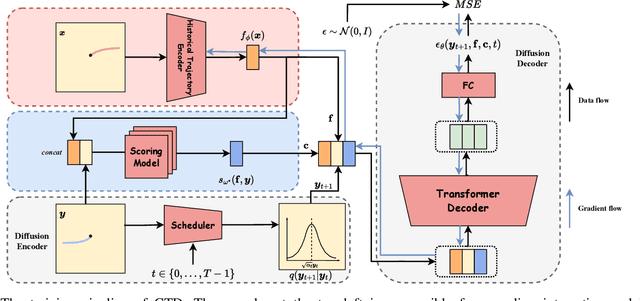
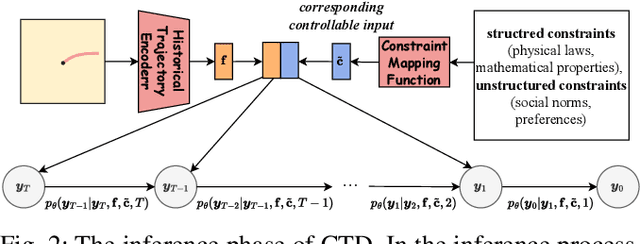
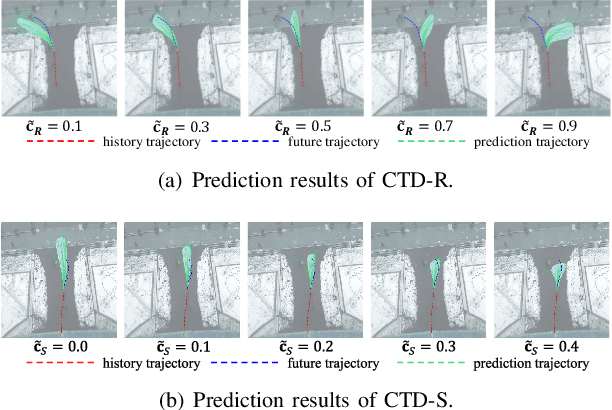
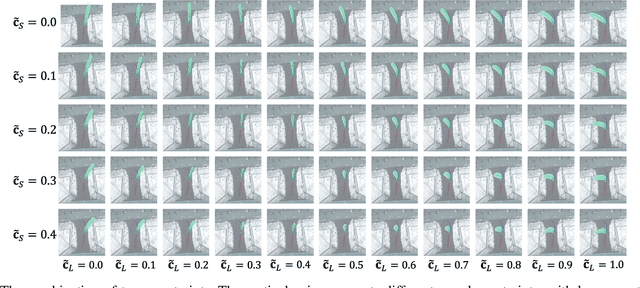
Abstract:Trajectory prediction facilitates effective planning and decision-making, while constrained trajectory prediction integrates regulation into prediction. Recent advances in constrained trajectory prediction focus on structured constraints by constructing optimization objectives. However, handling unstructured constraints is challenging due to the lack of differentiable formal definitions. To address this, we propose a novel method for constrained trajectory prediction using a conditional generative paradigm, named Controllable Trajectory Diffusion (CTD). The key idea is that any trajectory corresponds to a degree of conformity to a constraint. By quantifying this degree and treating it as a condition, a model can implicitly learn to predict trajectories under unstructured constraints. CTD employs a pre-trained scoring model to predict the degree of conformity (i.e., a score), and uses this score as a condition for a conditional diffusion model to generate trajectories. Experimental results demonstrate that CTD achieves high accuracy on the ETH/UCY and SDD benchmarks. Qualitative analysis confirms that CTD ensures adherence to unstructured constraints and can predict trajectories that satisfy combinatorial constraints.
Causal Mean Field Multi-Agent Reinforcement Learning
Feb 20, 2025
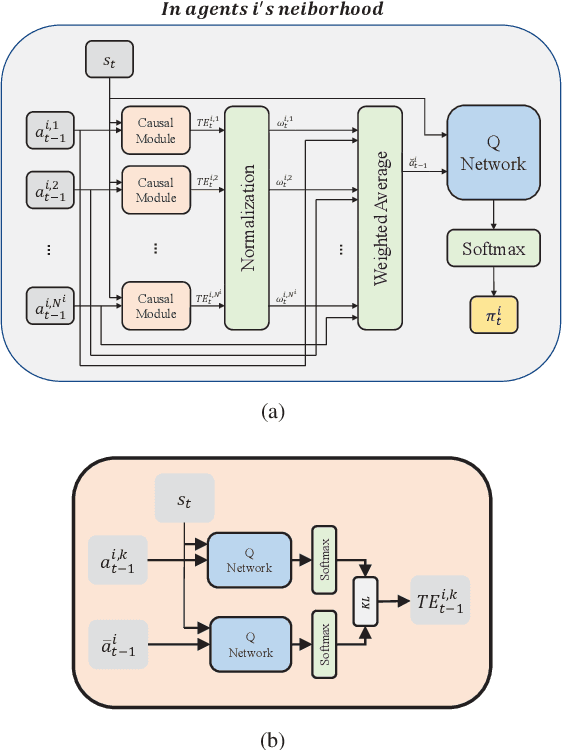
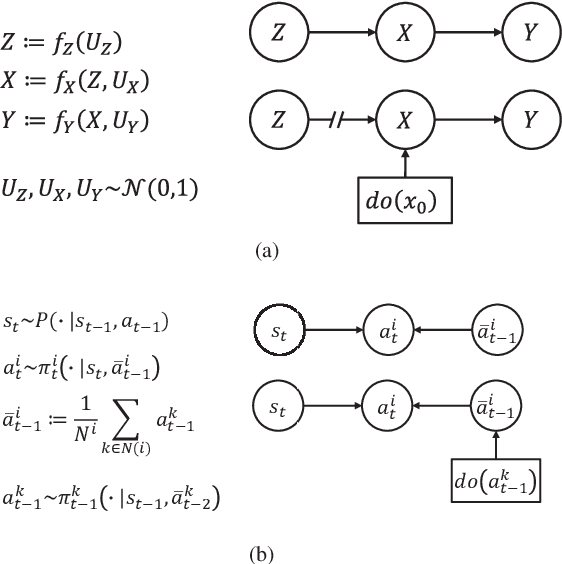
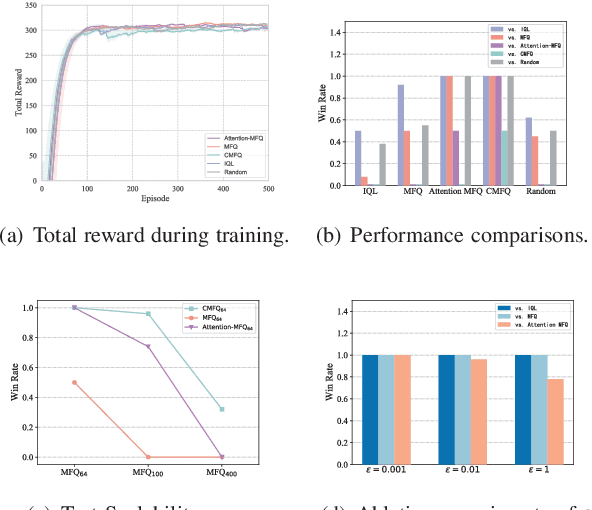
Abstract:Scalability remains a challenge in multi-agent reinforcement learning and is currently under active research. A framework named mean-field reinforcement learning (MFRL) could alleviate the scalability problem by employing the Mean Field Theory to turn a many-agent problem into a two-agent problem. However, this framework lacks the ability to identify essential interactions under nonstationary environments. Causality contains relatively invariant mechanisms behind interactions, though environments are nonstationary. Therefore, we propose an algorithm called causal mean-field Q-learning (CMFQ) to address the scalability problem. CMFQ is ever more robust toward the change of the number of agents though inheriting the compressed representation of MFRL's action-state space. Firstly, we model the causality behind the decision-making process of MFRL into a structural causal model (SCM). Then the essential degree of each interaction is quantified via intervening on the SCM. Furthermore, we design the causality-aware compact representation for behavioral information of agents as the weighted sum of all behavioral information according to their causal effects. We test CMFQ in a mixed cooperative-competitive game and a cooperative game. The result shows that our method has excellent scalability performance in both training in environments containing a large number of agents and testing in environments containing much more agents.
Vision-Based Generic Potential Function for Policy Alignment in Multi-Agent Reinforcement Learning
Feb 19, 2025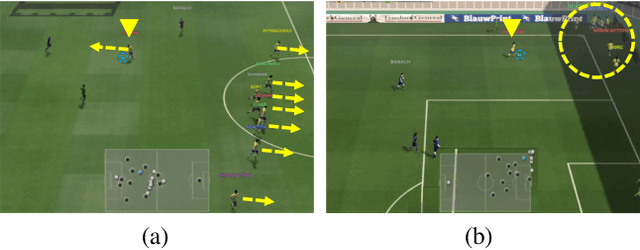
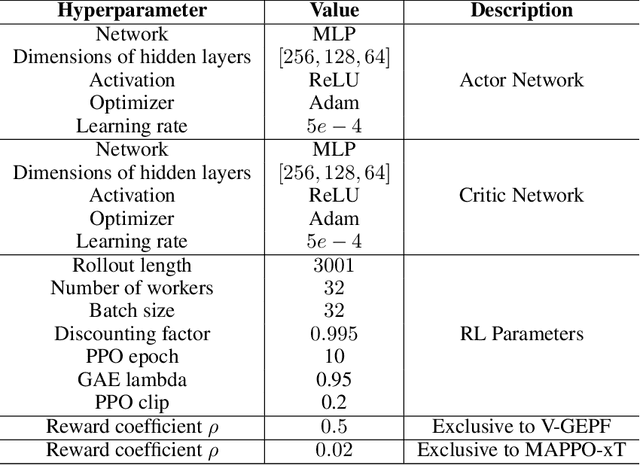
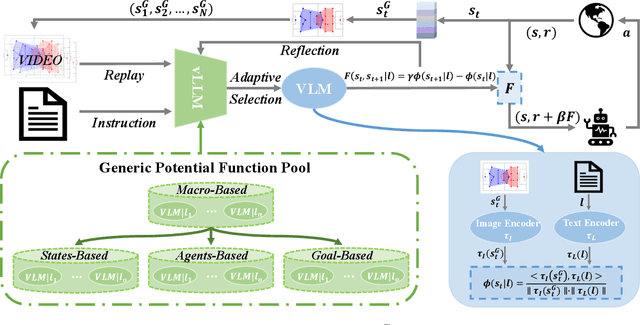
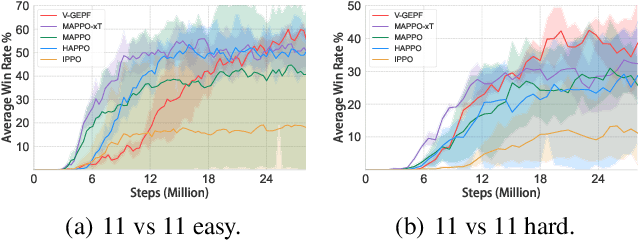
Abstract:Guiding the policy of multi-agent reinforcement learning to align with human common sense is a difficult problem, largely due to the complexity of modeling common sense as a reward, especially in complex and long-horizon multi-agent tasks. Recent works have shown the effectiveness of reward shaping, such as potential-based rewards, to enhance policy alignment. The existing works, however, primarily rely on experts to design rule-based rewards, which are often labor-intensive and lack a high-level semantic understanding of common sense. To solve this problem, we propose a hierarchical vision-based reward shaping method. At the bottom layer, a visual-language model (VLM) serves as a generic potential function, guiding the policy to align with human common sense through its intrinsic semantic understanding. To help the policy adapts to uncertainty and changes in long-horizon tasks, the top layer features an adaptive skill selection module based on a visual large language model (vLLM). The module uses instructions, video replays, and training records to dynamically select suitable potential function from a pre-designed pool. Besides, our method is theoretically proven to preserve the optimal policy. Extensive experiments conducted in the Google Research Football environment demonstrate that our method not only achieves a higher win rate but also effectively aligns the policy with human common sense.
OMoE: Diversifying Mixture of Low-Rank Adaptation by Orthogonal Finetuning
Jan 17, 2025



Abstract:Building mixture-of-experts (MoE) architecture for Low-rank adaptation (LoRA) is emerging as a potential direction in parameter-efficient fine-tuning (PEFT) for its modular design and remarkable performance. However, simply stacking the number of experts cannot guarantee significant improvement. In this work, we first conduct qualitative analysis to indicate that experts collapse to similar representations in vanilla MoE, limiting the capacity of modular design and computational efficiency. Ulteriorly, Our analysis reveals that the performance of previous MoE variants maybe limited by a lack of diversity among experts. Motivated by these findings, we propose Orthogonal Mixture-of-Experts (OMoE), a resource-efficient MoE variant that trains experts in an orthogonal manner to promote diversity. In OMoE, a Gram-Schmidt process is leveraged to enforce that the experts' representations lie within the Stiefel manifold. By applying orthogonal constraints directly to the architecture, OMoE keeps the learning objective unchanged, without compromising optimality. Our method is simple and alleviates memory bottlenecks, as it incurs minimal experts compared to vanilla MoE models. Experiments on diverse commonsense reasoning benchmarks demonstrate that OMoE can consistently achieve stable and efficient performance improvement when compared with the state-of-the-art methods while significantly reducing the number of required experts.
Coevolving with the Other You: Fine-Tuning LLM with Sequential Cooperative Multi-Agent Reinforcement Learning
Oct 08, 2024



Abstract:Reinforcement learning (RL) has emerged as a pivotal technique for fine-tuning large language models (LLMs) on specific tasks. However, prevailing RL fine-tuning methods predominantly rely on PPO and its variants. Though these algorithms are effective in general RL settings, they often exhibit suboptimal performance and vulnerability to distribution collapse when applied to the fine-tuning of LLMs. In this paper, we propose CORY, extending the RL fine-tuning of LLMs to a sequential cooperative multi-agent reinforcement learning framework, to leverage the inherent coevolution and emergent capabilities of multi-agent systems. In CORY, the LLM to be fine-tuned is initially duplicated into two autonomous agents: a pioneer and an observer. The pioneer generates responses based on queries, while the observer generates responses using both the queries and the pioneer's responses. The two agents are trained together. During training, the agents exchange roles periodically, fostering cooperation and coevolution between them. Experiments evaluate CORY's performance by fine-tuning GPT-2 and Llama-2 under subjective and objective reward functions on the IMDB Review and GSM8K datasets, respectively. Results show that CORY outperforms PPO in terms of policy optimality, resistance to distribution collapse, and training robustness, thereby underscoring its potential as a superior methodology for refining LLMs in real-world applications.
Efficient Multi-Task Reinforcement Learning via Task-Specific Action Correction
Apr 09, 2024Abstract:Multi-task reinforcement learning (MTRL) demonstrate potential for enhancing the generalization of a robot, enabling it to perform multiple tasks concurrently. However, the performance of MTRL may still be susceptible to conflicts between tasks and negative interference. To facilitate efficient MTRL, we propose Task-Specific Action Correction (TSAC), a general and complementary approach designed for simultaneous learning of multiple tasks. TSAC decomposes policy learning into two separate policies: a shared policy (SP) and an action correction policy (ACP). To alleviate conflicts resulting from excessive focus on specific tasks' details in SP, ACP incorporates goal-oriented sparse rewards, enabling an agent to adopt a long-term perspective and achieve generalization across tasks. Additional rewards transform the original problem into a multi-objective MTRL problem. Furthermore, to convert the multi-objective MTRL into a single-objective formulation, TSAC assigns a virtual expected budget to the sparse rewards and employs Lagrangian method to transform a constrained single-objective optimization into an unconstrained one. Experimental evaluations conducted on Meta-World's MT10 and MT50 benchmarks demonstrate that TSAC outperforms existing state-of-the-art methods, achieving significant improvements in both sample efficiency and effective action execution.
Prioritized League Reinforcement Learning for Large-Scale Heterogeneous Multiagent Systems
Mar 26, 2024Abstract:Large-scale heterogeneous multiagent systems feature various realistic factors in the real world, such as agents with diverse abilities and overall system cost. In comparison to homogeneous systems, heterogeneous systems offer significant practical advantages. Nonetheless, they also present challenges for multiagent reinforcement learning, including addressing the non-stationary problem and managing an imbalanced number of agents with different types. We propose a Prioritized Heterogeneous League Reinforcement Learning (PHLRL) method to address large-scale heterogeneous cooperation problems. PHLRL maintains a record of various policies that agents have explored during their training and establishes a heterogeneous league consisting of diverse policies to aid in future policy optimization. Furthermore, we design a prioritized policy gradient approach to compensate for the gap caused by differences in the number of different types of agents. Next, we use Unreal Engine to design a large-scale heterogeneous cooperation benchmark named Large-Scale Multiagent Operation (LSMO), which is a complex two-team competition scenario that requires collaboration from both ground and airborne agents. We use experiments to show that PHLRL outperforms state-of-the-art methods, including QTRAN and QPLEX in LSMO.
Self-Clustering Hierarchical Multi-Agent Reinforcement Learning with Extensible Cooperation Graph
Mar 26, 2024



Abstract:Multi-Agent Reinforcement Learning (MARL) has been successful in solving many cooperative challenges. However, classic non-hierarchical MARL algorithms still cannot address various complex multi-agent problems that require hierarchical cooperative behaviors. The cooperative knowledge and policies learned in non-hierarchical algorithms are implicit and not interpretable, thereby restricting the integration of existing knowledge. This paper proposes a novel hierarchical MARL model called Hierarchical Cooperation Graph Learning (HCGL) for solving general multi-agent problems. HCGL has three components: a dynamic Extensible Cooperation Graph (ECG) for achieving self-clustering cooperation; a group of graph operators for adjusting the topology of ECG; and an MARL optimizer for training these graph operators. HCGL's key distinction from other MARL models is that the behaviors of agents are guided by the topology of ECG instead of policy neural networks. ECG is a three-layer graph consisting of an agent node layer, a cluster node layer, and a target node layer. To manipulate the ECG topology in response to changing environmental conditions, four graph operators are trained to adjust the edge connections of ECG dynamically. The hierarchical feature of ECG provides a unique approach to merge primitive actions (actions executed by the agents) and cooperative actions (actions executed by the clusters) into a unified action space, allowing us to integrate fundamental cooperative knowledge into an extensible interface. In our experiments, the HCGL model has shown outstanding performance in multi-agent benchmarks with sparse rewards. We also verify that HCGL can easily be transferred to large-scale scenarios with high zero-shot transfer success rates.
 Add to Chrome
Add to Chrome Add to Firefox
Add to Firefox Add to Edge
Add to Edge